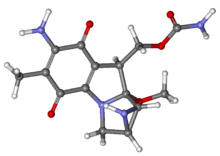Mitomycin C
 | |
 | |
| Clinical data | |
|---|---|
| Pregnancy category | |
| Legal status | |
| Legal status | |
| Pharmacokinetic data | |
| Metabolism | Hepatic |
| Biological half-life | 8–48 min |
| Identifiers | |
| |
| CAS Number | 50-07-7 |
| PubChem (CID) | 5746 |
| IUPHAR/BPS | 7089 |
| DrugBank | DB00305 |
| ChemSpider | 5544 |
| UNII | 50SG953SK6 |
| KEGG | C06681 |
| ChEBI | CHEBI:27504 |
| ChEMBL | CHEMBL105 |
| ECHA InfoCard | 100.000.008 |
| Chemical and physical data | |
| Formula | C=15 |
| Molar mass | 154.17 g·mol−1 |
| 3D model (Jmol) | Interactive image |
| Melting point | 360 °C (680 °F) |
| Solubility in water | 8.43 g L−1 mg/mL (20 °C) |
| |
| |
Mitomycin C is a mitomycin that is used as a chemotherapeutic agent by virtue of its antitumour activity. It is given intravenously to treat upper gastro-intestinal cancers (e.g. esophageal carcinoma), anal cancers, and breast cancers, as well as by bladder instillation for superficial bladder tumours. It causes delayed bone marrow toxicity and therefore it is usually administered at 6-weekly intervals. Prolonged use may result in permanent bone-marrow damage. It may also cause lung fibrosis and renal damage.
Mitomycin C has also been used topically rather than intravenously in several areas. The first is cancers, particularly bladder cancers and intraperitoneal tumours. It is now well known that a single instillation of this agent within 6 hours of bladder tumor resection can prevent recurrence. The second is in eye surgery where mitomycin C 0.02% is applied topically to prevent scarring during glaucoma filtering surgery and to prevent haze after PRK or LASIK; mitomycin C has also been shown to reduce fibrosis in strabismus surgery.[1] The third is in esophageal and tracheal stenosis where application of mitomycin C onto the mucosa immediately following dilatation will decrease re-stenosis by decreasing the production of fibroblasts and scar tissue.
Mitomycin C is a potent DNA crosslinker. A single crosslink per genome has shown to be effective in killing bacteria. This is accomplished by reductive activation of mitomycin to form a mitosene, which reacts successively via N-alkylation of two DNA bases. Both alkylations are sequence specific for a guanine nucleoside in the sequence 5'-CpG-3'.[2] Potential bis-alkylating heterocylic quinones were synthetised in order to explore their antitumoral activities by bioreductive alkylation.[3] Mitomycin is also used as a chemotherapeutic agent in glaucoma surgery.
References
- ↑ Kersey JP, Vivian AJ (Jul–Sep 2008). "Mitomycin and amniotic membrane: a new method of reducing adhesions and fibrosis in strabismus surgery". Strabismus. pp. 116–118. doi:10.1080/09273970802405493. PMID 18788060.
- ↑ Tomasz, Maria (September 1995). "Mitomycin C: small, fast and deadly (but very selective).". Chemistry and Biology. 2 (9): 575–579. doi:10.1016/1074-5521(95)90120-5. PMID 9383461.
- ↑ Renault, J.; Baron, M; Mailliet, P.; et al. (1981). "Heterocyclic quinones 2. Quinoxaline-5,6-(and 5-8)-diones - Potential antitumoral agents". Eur. J. Med. Chem. 16 (6): 545–550.